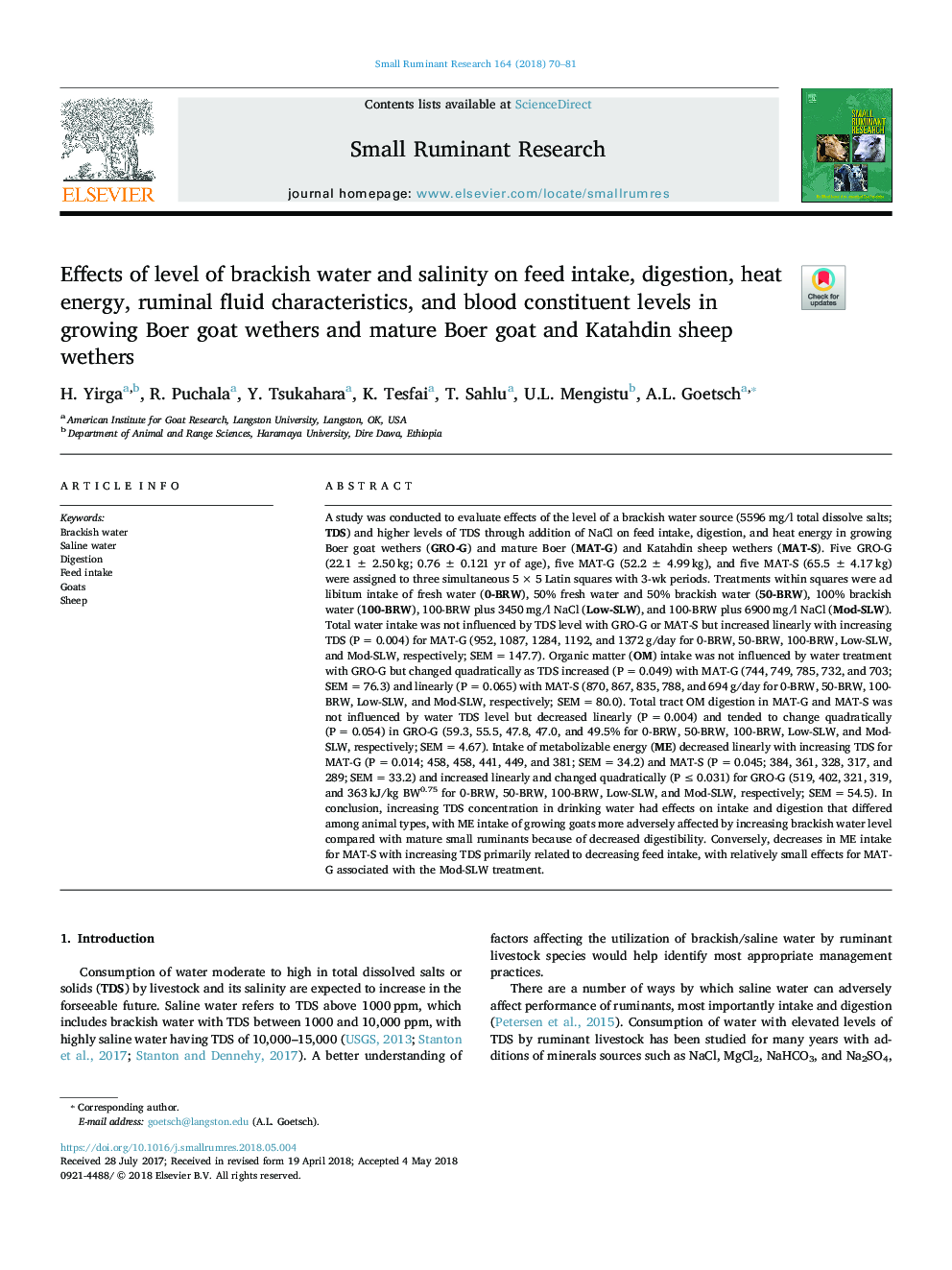| Article ID | Journal | Published Year | Pages | File Type |
|---|---|---|---|---|
| 8504169 | Small Ruminant Research | 2018 | 12 Pages |
Abstract
A study was conducted to evaluate effects of the level of a brackish water source (5596â¯mg/l total dissolve salts; TDS) and higher levels of TDS through addition of NaCl on feed intake, digestion, and heat energy in growing Boer goat wethers (GRO-G) and mature Boer (MAT-G) and Katahdin sheep wethers (MAT-S). Five GRO-G (22.1â¯Â±â¯2.50â¯kg; 0.76â¯Â±â¯0.121 yr of age), five MAT-G (52.2â¯Â±â¯4.99â¯kg), and five MAT-S (65.5â¯Â±â¯4.17â¯kg) were assigned to three simultaneous 5â¯Ãâ¯5 Latin squares with 3-wk periods. Treatments within squares were ad libitum intake of fresh water (0-BRW), 50% fresh water and 50% brackish water (50-BRW), 100% brackish water (100-BRW), 100-BRW plus 3450â¯mg/l NaCl (Low-SLW), and 100-BRW plus 6900â¯mg/l NaCl (Mod-SLW). Total water intake was not influenced by TDS level with GRO-G or MAT-S but increased linearly with increasing TDS (Pâ¯=â¯0.004) for MAT-G (952, 1087, 1284, 1192, and 1372â¯g/day for 0-BRW, 50-BRW, 100-BRW, Low-SLW, and Mod-SLW, respectively; SEMâ¯=â¯147.7). Organic matter (OM) intake was not influenced by water treatment with GRO-G but changed quadratically as TDS increased (Pâ¯=â¯0.049) with MAT-G (744, 749, 785, 732, and 703; SEMâ¯=â¯76.3) and linearly (Pâ¯=â¯0.065) with MAT-S (870, 867, 835, 788, and 694â¯g/day for 0-BRW, 50-BRW, 100-BRW, Low-SLW, and Mod-SLW, respectively; SEMâ¯=â¯80.0). Total tract OM digestion in MAT-G and MAT-S was not influenced by water TDS level but decreased linearly (Pâ¯=â¯0.004) and tended to change quadratically (Pâ¯=â¯0.054) in GRO-G (59.3, 55.5, 47.8, 47.0, and 49.5% for 0-BRW, 50-BRW, 100-BRW, Low-SLW, and Mod-SLW, respectively; SEMâ¯=â¯4.67). Intake of metabolizable energy (ME) decreased linearly with increasing TDS for MAT-G (Pâ¯=â¯0.014; 458, 458, 441, 449, and 381; SEMâ¯=â¯34.2) and MAT-S (Pâ¯=â¯0.045; 384, 361, 328, 317, and 289; SEMâ¯=â¯33.2) and increased linearly and changed quadratically (Pâ¯â¤â¯0.031) for GRO-G (519, 402, 321, 319, and 363â¯kJ/kg BW0.75 for 0-BRW, 50-BRW, 100-BRW, Low-SLW, and Mod-SLW, respectively; SEMâ¯=â¯54.5). In conclusion, increasing TDS concentration in drinking water had effects on intake and digestion that differed among animal types, with ME intake of growing goats more adversely affected by increasing brackish water level compared with mature small ruminants because of decreased digestibility. Conversely, decreases in ME intake for MAT-S with increasing TDS primarily related to decreasing feed intake, with relatively small effects for MAT-G associated with the Mod-SLW treatment.
Related Topics
Life Sciences
Agricultural and Biological Sciences
Animal Science and Zoology
Authors
H. Yirga, R. Puchala, Y. Tsukahara, K. Tesfai, T. Sahlu, U.L. Mengistu, A.L. Goetsch,
